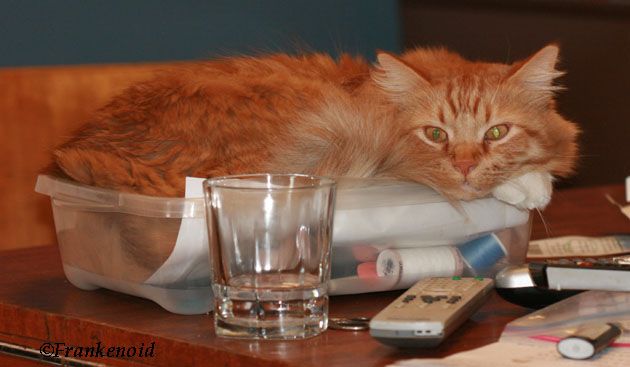Balderdash! It's just a matter of what one is accustomed to -- and it is amazing just how quickly 000 needles become "normal".
If you can sew on a button, you can knit on 000 needles -- which are larger than a sewing needle -- using the very same thread with which you would sew on that button (at least if you sew with cotton thread). If, like me, you have middle-aged eyes, use whatever level of reading glasses you would need to sew on a button and you'll be just fine.
 I will admit that knitting with 6/0 (.75 mm) needles is more difficult, as by that point the needles are flexible and wire like; you'll need thread finer than sewing thread and it is hard to see what you are doing, but a magnifying light takes care of that problem; and you do need to adapt decrease techniques such that one is only handling one stitch at a time (relying on slipping stitches over from either the left or right depending on the desired decrease) -- really, going to this size is more a matter of "yes I fucking can do this", and a display of virtuosity than pure enjoyment. But I have done it with Kinzel's Daffodil; and I will do it again with Niebling's Lyra.
I will admit that knitting with 6/0 (.75 mm) needles is more difficult, as by that point the needles are flexible and wire like; you'll need thread finer than sewing thread and it is hard to see what you are doing, but a magnifying light takes care of that problem; and you do need to adapt decrease techniques such that one is only handling one stitch at a time (relying on slipping stitches over from either the left or right depending on the desired decrease) -- really, going to this size is more a matter of "yes I fucking can do this", and a display of virtuosity than pure enjoyment. But I have done it with Kinzel's Daffodil; and I will do it again with Niebling's Lyra.But, back to the main topic (and I do have a tendency to make a lot of side excursions, as one can glean from all the parentheticals and emdashes and elipses -- it's just how my mind works) of keeping tension.
It's just like using a sewing machine (and I'm back at sewing metaphors which is odd as I really, really, really dislike sewing -- well, except playing with my Singer treadle machine is kinda fun).
If you're getting incorrect tension on your sewing machine, the first thing to check is did you miss one of the thread-through spots? Or, conversely, did you pass the thread over a machine part where it shouldn't be?
Tensioning yarn when knitting is just the same: how much tension you have depends on how many places the yarn has to pass through/over -- the more friction spots, the more tension. Smaller yarn needs more tension applied to it than a thick yarn, so smaller yarn needs to wind through more places.
I knit Continental style. If I'm knitting something with a sport weight yarn, the yarn goes over my little finger, under the ring and middle finger, then over the index finger.
When knitting with cotton sewing thread, I wrap the thread around my little finger once or twice, then wrap the thread around my ring finger, before going under the middle finger and over my index finger. It can get problematic, though, as sometimes my fingers will get all tangled up in the thread just when I need to quickly drop my knitting and prevent some household disaster or another from happening (and there almost always is the potential for some household disaster or another).
The gossamer cashmere/silk yarn I'm using for the Princess Shawl requires even more tensioning and has a tendency to wrap around itself, so I'm using yet another trick: weighing the yarn down with coiless safety pins (you can find them in the jewelry making section of a good crafts store).
Make sure there's a gap between where you are sitting, and where you've put your yarn. Then just hang two, three or however many safety pins it takes on the yarn, and allow them to hang in the gap between you and the yarn. The advantage to this method is that, as well as providing consistent tension on the yarn (and not ending up with your fingers entangled by yarn running over-under-around-and-through them), it also keeps the yarn from twisting back on itself and knotting. A real win-win.
 Of course if one has cats like the ever-helpful and charming Caligula (seen here "guarding" the tools of my craft), one will need to watch out for a fascination with the swinging safety pins. So far, though, that hasn't been a major problem.
Of course if one has cats like the ever-helpful and charming Caligula (seen here "guarding" the tools of my craft), one will need to watch out for a fascination with the swinging safety pins. So far, though, that hasn't been a major problem.[UPDATE] Even better: I've found that my lace needle gauge makes a wonderful weight -- it's just right for the cashmere/silk; I don't have to wind the yarn around my fingers at all!
No comments:
Post a Comment